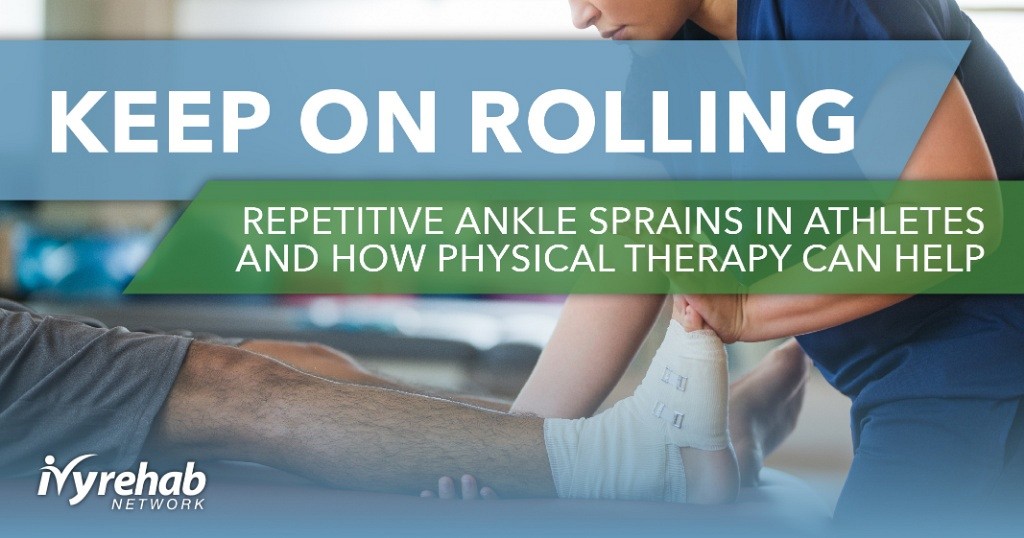Ankle sprains can be painful and debilitating, taking you out of the game or off the job for a few days or a few weeks. If you sprained your ankle as a child, an athlete, or even doing an everyday activity, you’re more prone to roll the same ankle again and again. Repetitive ankle sprains are no coincidence and can lead to chronic ankle pain, arthritis, and instability. An initial sprain often leads to repetitive ankle sprains After spraining your ankle for the first time, it increases the likelihood of it happening again. This problem is common among athletes whose sports require frequent quick changes in direction and jumping, such as basketball, football, and soccer.
Why Does This Happen?
A sprain is an injury to ligaments. That initial ankle sprain causes micro-damage to the small ligaments in your foot and ankle whose jobs are to help provide stability to the joint. This micro-damage results in your ligaments getting stretched out or torn. Sprains range from mild to severe and can take days to several weeks to heal, depending on the extent of the injury to ligaments. Unfortunately, your ligaments are not elastic and do not shorten back to their original size after being damaged. They stay stretched out and loose. Walking off a step or curb or even an awkward landing playing basketball or tennis can lead to another sprain due to a weak or unstable ankle. In addition, many athletes return to their sport before the ankle is properly healed and rehabilitated.
People with chronic ankle instability often complain of:
- Repeated turning or rolling of the ankle, especially on uneven surfaces or playing sports
- Pain or tenderness
- Chronic discomfort and swelling
- The ankle feeling wobbly or unstable
Sprains Inhibit Sensory Signals
Besides helping to stabilize the joint, ligaments perform another very important job. They send sensory signals to your brain known as proprioception. Proprioception is your unconscious awareness of where your body is in space. In laymen’s terms, it’s how you know if you are standing on an even, flat surface or if your foot is on top of rock without looking down. This is extremely important when it comes to repetitive ankle sprains. People who have previously sprained an ankle have overstretched these ligaments. When the ligaments are damaged and overstretched, it limits their ability to send the proprioceptive information to your brain. This lack of information hinders the brain from sensing when the ankle is beginning to roll over until it’s too late.
Retrain Your Brain with Physical Therapy
At Ivy Rehab, you will receive an individualized treatment program that is aimed at getting you back to your former, pain-free self as quickly as possible. Other treatment options for an ankle injury or repetitive ankle sprains include soft tissue mobilization, aquatic therapy, BioSway, dry needling, and orthopedic therapy. Wearing a brace, especially during sports, supports the ankle to prevent future sprains. Physical therapy also focuses on retraining your brain and stabilizing the ankle to keep it strong and healthy.
Physical therapists help guide you through various stretches and strengthening exercises to restore ankle strength and movement. Most importantly, they create a plan of care that includes challenging and unique balancing activities to retrain your ankle/foot muscles and your brain to work together. Without incorporating these crucial balancing exercises, the brain and leg muscles never learn how to work together in order to compensate for the overstretched ligaments. This is why athletes continue to re-sprain their ankles even after giving the injury sufficient time to heal.
A Few Other Things You Can Do:
- Choose footwear based on activity and wear supportive shoes when playing sports or hiking
- Be aware of the surface; gravel, sand, and trails create increased stress to the ankle ligaments
- Strengthen your leg, foot, hip, and core muscles
- Work on improving your balance reactions
- Maintain full ankle dorsiflexion (when you pull your toes towards your face)
- Open up the Achilles and calf with exercises
- Use your whole foot and roll off the big toe side of your foot when walking
Repetitive ankle sprains are no fun and often send athletes to the sidelines. Don’t wait until you roll your ankle again to seek help. Request an appointment at your local Ivy Rehab Network clinic to get started on a program that will strengthen your ankle, retrain your brain and leg muscles to work together to prevent future injury, and return you back to your normal level of activity.
Article Reviewed by Holly Lookabaugh-Deur, PT, DSc, GCS, CEEAA
Holly Lookabaugh-Deur, PT, DSc, GCS, CEEAA is a practicing physical therapist and a partner and Director of Clinical Services at Ivy Rehab Network. Deur is board certified as a geriatric clinical specialist and certified exercise expert for aging adults with more than 35 years of clinical experience. She is certified as an aquatic and oncology rehabilitation specialist and serves as adjunct faculty at Central Michigan University and Grand Valley State University.







